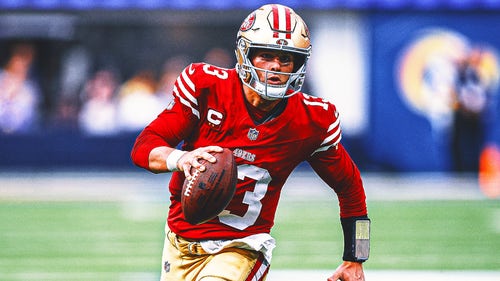
One way or another, Colin Kaepernick can't be the 49ers' backup quarterback anymore
The 49ers have two choices regarding Colin Kaepernick at this point: Play him. Or release him.
There is, of course, a third door that Chip Kelly walked through and then slammed behind him at the start of the season. Each week of the regular season, including Thursday’s home loss to Arizona, Kaepernick has served as the backup—dressed and active on game days—behind Blaine Gabbert.
That plan makes no sense. None. It doesn’t give the 49ers a realistic chance to win games in 2016, and it doesn’t help them find an answer at QB for the 2017 season.

Despite Phil Simms’s claims to the contrary on the game’s broadcast, Gabbert showed again Thursday that he is out of his depth as a starting quarterback in the NFL. Gabbert did run for 70 yards (the second-highest total of his career) and threw a touchdown pass to Jeremy Kerley, but he also daggered the 49ers’ offense on numerous occasions. His overthrow of an open Rod Streater on a deep post route was comically bad—the pass went sailing well over Streater’s head.
Yet, as the home crowd chanted for Kaepernick, Gabbert finished out the game, San Francisco’s fourth consecutive loss since a Week 1 victory.
“We’re 1–4,” 49ers coach Chip Kelly said. “We’ve got to make sure we’re giving ourselves the best chance to win, so we’re going to look at everything.”
Does that mean Kaepernick is on deck? If not, then what’s the point of keeping him around on the roster?
Kaepernick required surgeries on his right thumb and left knee during the off-season, after his 2015 campaign ended due to a torn labrum in his left (non-throwing) shoulder. Those injuries backed the 49ers into a corner with Kaepernick’s contract—his deal includes full injury-related guarantees, so Kaepernick likely would have needed to pass a physical (which he wouldn’t have) for San Francisco to cut him before his 2016 salary locked in back on April 1.
Kaepernick lost significant weight during the course of his rehab, and that’s been one of the factors cited by Kelly in why Kaepernick has yet to see game action this season.
“I don’t think he’s ready to go full time,” Kelly said, prior to Week 4. “He’s continuing to work on it. ... And Kap will be the first to tell you, if you guys have been around here before, I think his playing weight has been around 225, and he’s not at that right now. So he’s going out there and continuing to work, continuing to get better. He had a serious layoff in terms of being able to medical rehab. To get the full Kap for what you need, the potential that he has, he needs to continue to just work on the physical aspect of things.”
But this is part of why the 49ers’ QB depth chart thus far has been such a head-scratcher. If Kaepernick is not ready for game action, then why has Kelly kept him in uniform on game days, with Christian Ponder inactive? Thursday night, Gabbert was subjected to several big hits; any one of them could have resulted in an injury that forced Kaepernick into the lineup.
Kelly would have had to use Kaepernick in that event. Which brings up this question: Do the 49ers even want Kaepernick to play?

Kaepernick’s 2017 base salary of $14.5 million is again guaranteed for injury only prior to April 1. In other words, if the 49ers release him before that date, they would be on the hook only for the remainder of his signing bonus (a little less than $5 million). If he were to suffer an injury that lingered through the off-season, though, Kaepernick could force the 49ers to pick up that tab ... just as they did this year.
A similar contract setup came into play last season with Washington and Robert Griffin III. With Griffin’s 2017 salary tied to an injury-only guarantee, the Redskins scratched him from the game-day roster to avoid any health problems.
Simply releasing Kaepernick now would force the 49ers to just take the loss on his tenure, with no return for losing him. Perhaps they’re hoping they can trade him in the off-season for, well, whatever they can get: a late-round pick, a coupon to Waffle House, something.
There also is the conundrum of the team’s public image. Were Kaepernick to be released now, mere weeks after he became the face of the controversial but spreading national anthem protests, the franchise would leave itself open to backlash.

At some point, though, the 49ers have to make a call on Kaepernick’s actual role. Gabbert is not a long-term (nor a short-term) answer. Even a full clearing of the slate—benching Gabbert, releasing Kaepernick, plucking a young quarterback like Kevin Hogan or Aaron Murray off another team’s practice squad—at least takes a step toward the future.
However, the 49ers are paying Kaepernick nearly $16 million for this season anyway, so Kelly may as well find out what he has left in the tank. If the 49ers do not want Kaepernick on the field, for whatever reason, keeping him glued to the bench while Gabbert flails does no good for anyone.
The Kaepernick who helped San Francisco to the Super Bowl in 2012 and back to the NFC title game the following season is a distant memory. Even before the labrum injury, he was regressing at an alarming rate. He still carries more upside than Gabbert, and certainly more than Ponder.
It’s time to play him, or to let him go and move on. Those are the only two options that should be on the table.
This article originally appeared on











